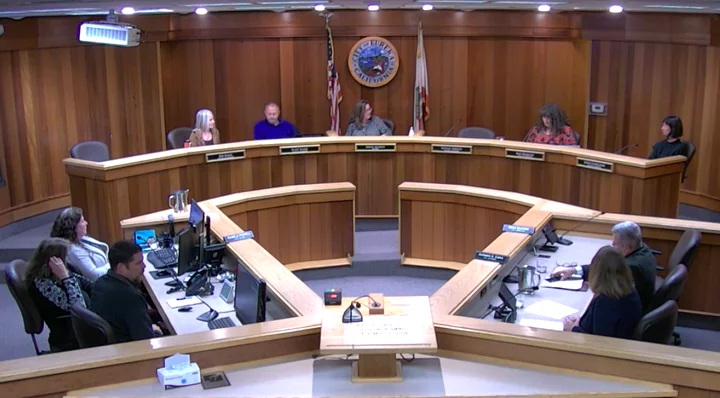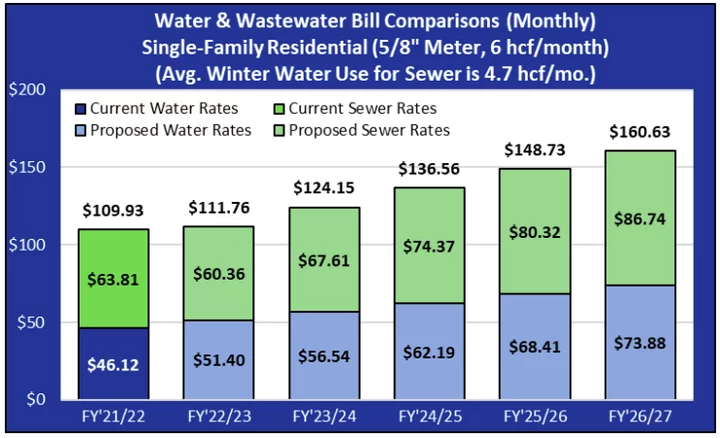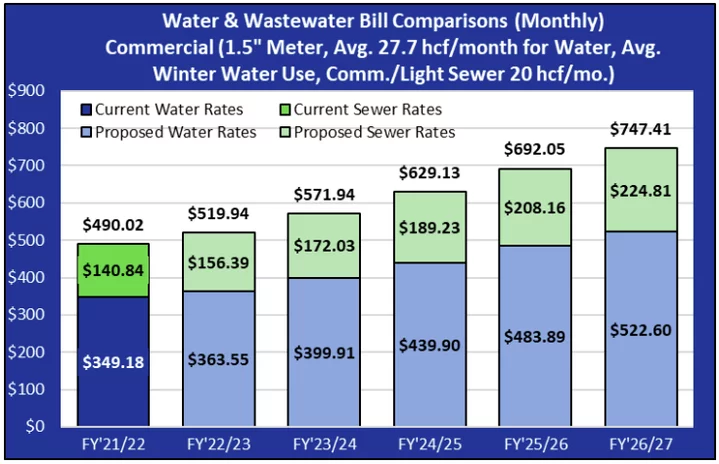Screenshot of Tuesday’s Eureka City Council meeting.
At the end of last month, homeowners were dismayed to find a letter from the City of Eureka informing them of an increase in their monthly utility bill.
The tax hike rate increase seeks to raise the City’s water and sewer rates incrementally over the next five years to cover capital improvements to the City’s infrastructure. Industry standards require municipalities to adjust water and sewer utilities rates periodically – typically every five years – to ensure rates are in keeping with inflation and accurately reflect operational costs. Rate increases are also necessary to ensure the City has sufficient revenue to cover capital projects and general maintenance while maintaining state-required reserves.
The last rate study, which was completed by NBS Consulting in 2016, implemented yearly rate increases through 2021. The City retained the same firm to perform the 2022 rate study for both utilities, assess alternative rate structures and review how costs are allocated to different customer classes.
“All customers are not created the same,” Deputy Public Works Director Brian Issa explained during Tuesday’s Eureka City Council meeting. “A restaurant is not the same as a single-family dwelling and serving both water [and] sewer to those [customers] is not equivalent. That’s why the rates are different for different customer classes.”
To determine individual rates and ensure everyone is paying their fair share, staff perform a Cost of Service Analysis (COSA) in which revenue requirements are apportioned to different customer classes based on their impacts on the system. In other words, customers who use more water and create more waste have to pay more because they require a higher level of service.
“To put it in perspective, the amount of BOD TSS [biological oxygen demand and total suspended solids] that Lost Coast Brewery sends down to the plant is roughly equivalent to – depending on the month – between 5,000 and 8,500 single-family residences,” Issa said, adding that “BOD TSS” is just a fancy term for “how much poop” will have to be treated. “Wrap your mind around that a little bit. The idea of ‘strength’ becomes a very, very important part of this when you look at the cost of service.”
How much will your utility rates increase? Water rates are expected to go up by eight to ten percent each year for the next five years, for a total increase of 58 percent. Sewer rates will go up by about four to ten percent per year for the five years for a total increase of 34 percent.
Screenshot
Screenshot
(If you’re looking for a more specific estimate, the City of Eureka created a handy little calculator to determine what your monthly bill will look like over the next five years. Check it out at this link.)
Councilmember Leslie Castellano said she understood that the rate increase would help the City pay for new meters, but asked whether the meters would be paid off in the same five-year period.
“Right now, the plan is to pay for them all up front, either through the use of reserves or through rate revenues in those years where we’re doing the replacements,” Issa said. “It’s possible you could bond for that and do it as a debt but then you’re paying insurance on that. If you have the money to do it, it might be more sensible to do it up front … because they’re dying at a fairly logarithmic rate and we’re going to need to replace them, hopefully, within a 12-month period. …We can also go to the State Revolving Loan Fund for that money because it’s fairly low interest.”
City Manager Miles Slattery added that “all of the things listed in the capital improvement project will be paid for in that five-year period.”
Councilmember Scott Bauer cautioned against taking out a loan, fearing it could put the City in debt.
“A lot of the stories you hear about, you know, privatization of sewer and water are because of debt obligations,” he said. “Municipalities borrow a bunch of money, realize they can’t pay it back, they sell their critical human services and then everybody’s rates go up astronomically. … If we can pay as we go and not take out more debt I’m in favor of that.”
The City Council will revisit the proposal during a public hearing on Dec. 19. If approved, the rate increase will take effect on Jan. 1, 2023.
In the meantime, residents who oppose the rate increase can submit a letter of protest to the City. Proposition 218 provides a process in which California residents can protest a proposed rate increase and prevent adoption by the City Council if protests are recorded for more than 50 percent of affected parcels. Protests must be submitted in writing.
For more information on the 2022 rate study, check out the FAQ page here.
###
Keeping with the theme of the evening, the council also reviewed and approved a revision to the City’s Private Sewer Lateral Ordinance.
The ordinance, adopted by the city council in 2019, shifted the responsibility of maintenance and repairs of the lower lateral – which is the sewer pipe connecting a property’s plumbing system to the public sewer main under the street – solely to the property owner. However, since the ordinance was adopted, staff has reported ongoing issues with laterals not being replaced by property owners when they should be, largely due to the cost.
“This update really was spawned out of some mechanical issues with the ordinance, in terms of actually implementing it with homeowners, as well as conversations with the Humboldt Association of Realtors and a desire on the part of some [local realtors] to actually see a point-of-sale [trigger] as an effort to add more certainty to the ordinance and take out some of the ambiguity,” Issa explained. “But at the rate that [clay] sewer laterals need to be replaced, our crews just don’t have the capacity to go out and replace all those laterals.”
On top of the added point-of-sale trigger, the ordinance revision would also implement a set fee.
“Rather than telling the homeowner they have to replace the lateral, go find a contractor and figure it out, they would just pay a set fee,” Issa said. “We’ll take that money, we’ll hire a contractor when we get enough of them put together… we’ll manage the project, we’ll deal with all the contractor bidding and all of that sort of stuff. Once you pay the fee, you’re sort of off the hook and the sale can proceed immediately.”
The fee amount would be based on the average City bid cost of lateral repair/replacement over the previous two years. Currently, the anticipated fee would fall under $10,000.
“The average cost, as I’m seeing right now, is somewhere around $8,000, with an additional amount for administration of the city bidding the project, inspecting and managing the project,” Issa said. Property owners who feel they can get a better deal through a private contractor will still have the ability to do so.
Councilmember Bauer asked how the City would handle cross-connections (when the sewer line is connected to a neighboring sewer line) and if both parties would be required to replace their sewer laterals at the point-of-sale.
“You would have to because you’re selling your property … but the other person would have to be done within a year,” Issa explained. “Typically, how I’ve been dealing with cross connections … we will do the new install because you have to tap the main and it’s better for us to work on our infrastructure. It doesn’t make any sense for us to go and install a new lateral and five feet away have a bad lateral in the ground and require that homeowner to go get somebody to come and fix it. We’ll just offer to do it at the same cost as a new install. … You can pay us to do it now and put both pipes in the same trench for $3,500 or you can go get somebody to do it for $10,000.”
Councilmember Natalie Arroyo asked about loan options and/or payment plans for homeowners, noting that a loan agreement “would be a little less onerous for folks.”
“We did originally talk about the loan program and the payments for the loan being attached to the water/sewer billing,” Issa said. “[It] did not roll out that way due to the logistics of the billing system and entering loans within the context of our billing software, so people have been getting that loan servicing separate from their water and sewer bill.”
Speaking on behalf of the Humboldt Association of Realtors during public comment, Tina Christensen said the proposed revision would alleviate the association’s primary concerns.
“[Staff has] corrected a lot of conditions that [the association] felt needed to be addressed better and it seems like you’ve done that,” she said. “The [Humboldt] Association of Realtors has sold over 600 houses since this came in and I guarantee you that a lot of those houses did not have lateral inspections. Because of the big disclosure laws in real estate now, we all came to an understanding that this is a big issue, and it’s an issue for both buyers and sellers alike.”
Following public comment and a brief discussion from the council, Arroyo made a motion to approve staff’s recommendation and apply the aforementioned revisions to the Private Sewer Lateral Ordinance. The motion passed in a unanimous 5-0 vote.
###
Earlier in the meeting, the council approved staff’s request to refinance a series of bonds related to the City’s Water Fund. Since interest rates are lower than in years past, staff thought now would be a good time to refinance the City’s debt.
The City Council will consider an identical request for the City’s Wastewater Fund next month. That item had originally appeared on this week’s agenda but was pulled because the City was offered an even lower interest rate for the wastewater bond.
###
You can find a recording of the meeting at this link.
###
NOTE: The original headline of this story described the City’s proposed water and sewer rate increase as a “tax hike.” The rate increase is not a tax, but a rate that is strictly regulated in accordance with Proposition 218. The Outpost regrets this error.



CLICK TO MANAGE